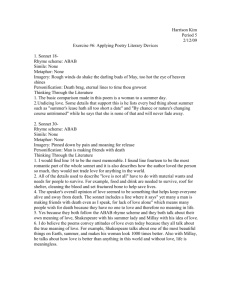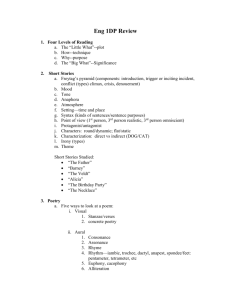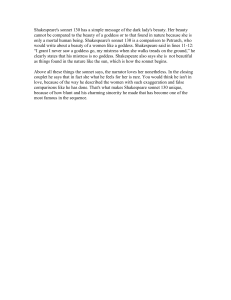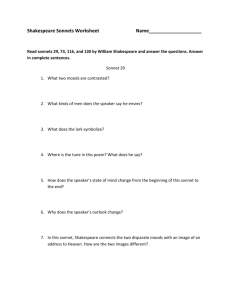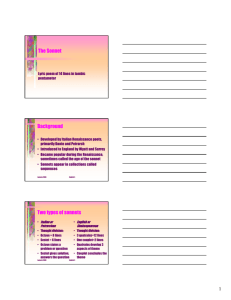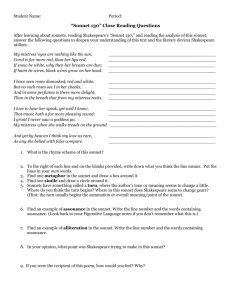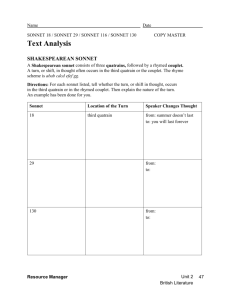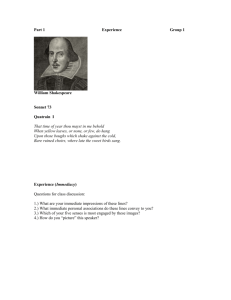Lesson Topic: Shakespeare's Sonnets 29 & 130 Grade
advertisement
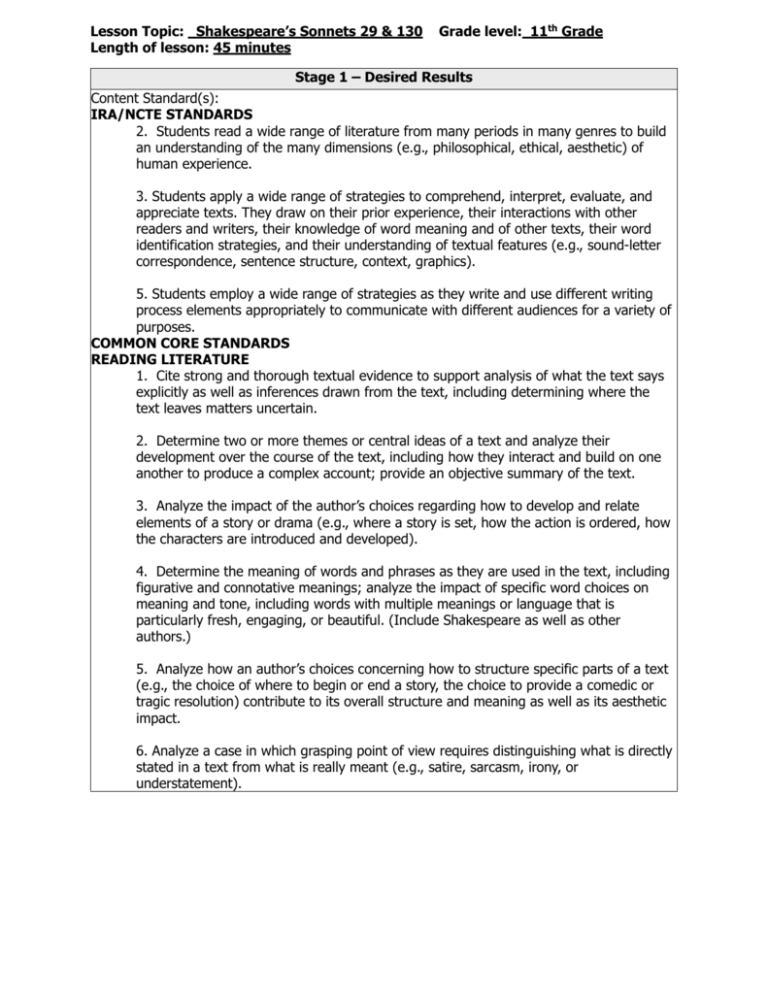
Lesson Topic: Shakespeare’s Sonnets 29 & 130 Length of lesson: 45 minutes Grade level: 11th Grade Stage 1 – Desired Results Content Standard(s): IRA/NCTE STANDARDS 2. Students read a wide range of literature from many periods in many genres to build an understanding of the many dimensions (e.g., philosophical, ethical, aesthetic) of human experience. 3. Students apply a wide range of strategies to comprehend, interpret, evaluate, and appreciate texts. They draw on their prior experience, their interactions with other readers and writers, their knowledge of word meaning and of other texts, their word identification strategies, and their understanding of textual features (e.g., sound-letter correspondence, sentence structure, context, graphics). 5. Students employ a wide range of strategies as they write and use different writing process elements appropriately to communicate with different audiences for a variety of purposes. COMMON CORE STANDARDS READING LITERATURE 1. Cite strong and thorough textual evidence to support analysis of what the text says explicitly as well as inferences drawn from the text, including determining where the text leaves matters uncertain. 2. Determine two or more themes or central ideas of a text and analyze their development over the course of the text, including how they interact and build on one another to produce a complex account; provide an objective summary of the text. 3. Analyze the impact of the author’s choices regarding how to develop and relate elements of a story or drama (e.g., where a story is set, how the action is ordered, how the characters are introduced and developed). 4. Determine the meaning of words and phrases as they are used in the text, including figurative and connotative meanings; analyze the impact of specific word choices on meaning and tone, including words with multiple meanings or language that is particularly fresh, engaging, or beautiful. (Include Shakespeare as well as other authors.) 5. Analyze how an author’s choices concerning how to structure specific parts of a text (e.g., the choice of where to begin or end a story, the choice to provide a comedic or tragic resolution) contribute to its overall structure and meaning as well as its aesthetic impact. 6. Analyze a case in which grasping point of view requires distinguishing what is directly stated in a text from what is really meant (e.g., satire, sarcasm, irony, or understatement). Lesson Topic: Shakespeare’s Sonnets 29 & 130 Length of lesson: 45 minutes Grade level: 11th Grade Understanding (s)/goals Essential Question(s): Students will understand: •What is true love? •The implications of Shakespeare's word choice •How do you express love in a genuine way? and structure on a sonnet’s meaning. •Why is love poetry such a long lived genre? •The development of an ‘argument’ in •Can Shakespeare’s sonnets connect to modern Shakespeare’s sonnets. life? •The connection of Shakespeare’s sonnets to •Is it possible to write about love without using contemporary texts about love, especially love trite language or clichés? poems, songs, and greeting cards. Student objectives (outcomes): Students will be able to: •Identify elements of a Shakespearian sonnet including rhyme scheme, quatrains, and couplets. •Interpret Shakespearian sonnets for meaning. •Evaluate Shakespeare’s intent in sonnets 29 and 130. •Determine if Shakespeare was successful in realizing his intent. •Make connections between Shakespeare’s sonnets and contemporary texts. Stage 2 – Assessment Evidence Performance Task(s): Other Evidence: •Group discussion •Think Aloud analysis of Sonnet 130 •Entrance and Exit Slips •Greeting Card Comparison Stage 3 – Learning Plan Learning Activities/Instructional Procedures: •Focusing event (something to get the students' attention): Opening Question •Which would you rather get from a significant other, a hallmark card or a hand written love poem? Why? •Students will have ~3min to write responses on a 3x5 card. •Teaching procedures (methods you will use) •Mini lecture on Shakespearian/English Sonnet form •ABAB CDCD EFEF GH rhyme scheme •3 quatrains and one couplet •Quatrain = 4 lines •Couplet = 2 lines •Rhythm/meter - iambic pentameter •Heart beat rhythm, soft and hard syllables alternate •Iamb = a metrical foot one short (unstressed) syllable followed by one long (stressed syllable. •Pentameter = a line of verse that contains five metrical feet •Metrical foot = the unit of syllables that makes up meter in poetry •Understanding structure can help us follow Shakespeare’s train of thought though his sonnets. •Think aloud interpretation of Sonnet 29 •Model to students what they will be doing in smaller groups with sonnet 130 •Small Group Work •Students will work in groups of 4 based on where they are sitting. •Each member of the group will practice using the Think Aloud technique to interpret sonnet 130. •Each member will be responsible for thinking aloud about 1 quatrain or couplet in the sonnet. The non-speaking members of the group listen, write down interesting connections or questions they have about what the speaker/thinker is saying. Lesson Topic: Shakespeare’s Sonnets 29 & 130 Length of lesson: 45 minutes Grade level: 11th Grade •Small Group Work Cont. •Students should use these recorded thoughts guide their analysis of the sonnet and to address the following questions: •Why did the author write this sonnet? •What is the author saying in this sonnet? •Does the author truly love the person this sonnet is written about? •Does the author like the person this sonnet is written about? •Is the author successful in conveying his message? Why or Why not? •Hallmark Card Comparison •Each group will be given one hallmark card to compare to Sonnet 130. •Students should analyze the card as a whole, interpreting text and images. They can use the following questions to aid in their analysis: •What is the message of this card? •What does this card tell the receiver about the giver? (i.e. That the giver loves them, is thoughtful, lazy, is trying to make up for something, etc…) •Does this card express its message in an original way? •Does this card rely on clichés? If so, which ones? •Is this card successful in conveying its intended message? •What other messages could this card send? •Compare this card and its message to Shakespeare’s sonnet 130 •Which one is better at conveying its message? •Which one is more original or creative? •Are there any similarities? •What differences seem the most important? •What role does cliché play in each? •Closure (how you will end the lesson) Exit Slip •Which would you rather get on Valentine’s Day - Sonnet 130 or a hallmark card? Why? •Can you think of a love song that is similar to sonnet 130? In what ways is it similar? •Students can choose which question to answer. They will have 2-3 minutes to write their response to the question on a 3x5 card that will be turned in as they leave class. Materials & Aids •10 Hallmark cards about romantic love •~100 3x5 notecards •Think Aloud activity guidelines (1 per group) •Hallmark Card Comparison guidelines (1 per group) •Blackboard and Chalk Lesson Topic: Shakespeare’s Sonnets 29 & 130 Length of lesson: 45 minutes Grade level: 11th Grade Think Aloud Activity You are going to use the Think Aloud technique that Ms. Watkins just demonstrated on Sonnet 130. Each person in your group will take a turn being the Talker thinking aloud about what their assigned lines mean or could mean. Your group will decide who will be Talker 1, 2, 3, and 4. While the Talker talks, the listeners should take notes. These notes will record the Talkerʼs ideas, questions these ideas raised, and anything else that seems like it will help the group understand what Shakespeare is saying. Talker #1 will “think aloud” about the first quatrain (lines 1-4). Talker #2 will “think aloud” about the second quatrain (lines 5-8). Talker #3 will “think aloud” about the third quatrain (lines 9-12). Talker #4 will “think aloud” about the final couplet (lines 13-14). When you have finished, use the ideas, questions, and insights from your think aloudʼs to analyze Sonnet 130. You address the following questions in your analysis: •Why did the author write this sonnet? •What is the author saying in this sonnet? •Does the author truly love the person this sonnet is written about? •Does the author like the person this sonnet is written about? •Is the author successful in conveying his message? Why or Why not? **Make sure you take notes! You will need to refer back to your analysis of Sonnet 130 later today!** Lesson Topic: Shakespeare’s Sonnets 29 & 130 Length of lesson: 45 minutes Grade level: 11th Grade Greeting Cards vs. Shakespeare You are going to compare your greeting card to Sonnet 130. Start out by focusing on your greeting card. Analyze it like you did Sonnet 130. Donʼt just focus on the text, but look at the entire card - its images, the way it is composed, the materials it is made of, etc… You should address some (if not all) of these questions in your analysis: •What is the message of this card? •What does this card tell the receiver about the giver? (i.e. That the giver loves them, is thoughtful, lazy, is trying to make up for something, etc…) •Does this card express its message in an original way? •Does this card rely on clichés? If so, which ones? •Is this card successful in conveying its intended message? •What other messages could this card send? Now go back to your notes about Sonnet 130. Compare these two love messages. Use the following questions to guide your discussion: •Which one is better at conveying its message? •Which one is more original or creative? •Are there any similarities? •What differences seem the most important? •What role does cliché play in each?

